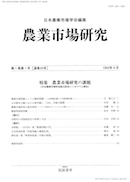Volume 12, Issue 2
Displaying 1-21 of 21 articles from this issue
- |<
- <
- 1
- >
- >|
-
2003Volume 12Issue 2 Pages 1-2
Published: December 31, 2003
Released on J-STAGE: March 30, 2019
Download PDF (279K) -
Article type: Paper
2003Volume 12Issue 2 Pages 3-12
Published: December 31, 2003
Released on J-STAGE: March 30, 2019
Download PDF (1199K) -
Article type: Paper
2003Volume 12Issue 2 Pages 13-24
Published: December 31, 2003
Released on J-STAGE: March 30, 2019
Download PDF (1377K) -
Article type: Paper
2003Volume 12Issue 2 Pages 25-32
Published: December 31, 2003
Released on J-STAGE: March 30, 2019
Download PDF (891K) -
2003Volume 12Issue 2 Pages 33-35
Published: December 31, 2003
Released on J-STAGE: March 30, 2019
Download PDF (364K)
-
Article type: Paper
2003Volume 12Issue 2 Pages 36-47
Published: December 31, 2003
Released on J-STAGE: March 30, 2019
Download PDF (1420K) -
Article type: Paper
2003Volume 12Issue 2 Pages 48-60
Published: December 31, 2003
Released on J-STAGE: March 30, 2019
Download PDF (1414K) -
Article type: Paper
2003Volume 12Issue 2 Pages 61-71
Published: December 31, 2003
Released on J-STAGE: March 30, 2019
Download PDF (1270K) -
Article type: Paper
2003Volume 12Issue 2 Pages 72-81
Published: December 31, 2003
Released on J-STAGE: March 30, 2019
Download PDF (1226K) -
Article type: Paper
2003Volume 12Issue 2 Pages 82-91
Published: December 31, 2003
Released on J-STAGE: March 30, 2019
Download PDF (1102K)
-
Article type: Working Paper
2003Volume 12Issue 2 Pages 95-98
Published: December 31, 2003
Released on J-STAGE: March 30, 2019
Download PDF (442K) -
Article type: Working Paper
2003Volume 12Issue 2 Pages 99-102
Published: December 31, 2003
Released on J-STAGE: March 30, 2019
Download PDF (494K) -
Article type: Working Paper
2003Volume 12Issue 2 Pages 103-106
Published: December 31, 2003
Released on J-STAGE: March 30, 2019
Download PDF (527K) -
Article type: Working Paper
2003Volume 12Issue 2 Pages 107-110
Published: December 31, 2003
Released on J-STAGE: March 30, 2019
Download PDF (443K) -
Article type: Working Paper
2003Volume 12Issue 2 Pages 111-114
Published: December 31, 2003
Released on J-STAGE: March 30, 2019
Download PDF (509K) -
Article type: Working Paper
2003Volume 12Issue 2 Pages 115-118
Published: December 31, 2003
Released on J-STAGE: March 30, 2019
Download PDF (472K) -
Article type: Working Paper
2003Volume 12Issue 2 Pages 119-122
Published: December 31, 2003
Released on J-STAGE: March 30, 2019
Download PDF (465K) -
Article type: Working Paper
2003Volume 12Issue 2 Pages 123-126
Published: December 31, 2003
Released on J-STAGE: March 30, 2019
Download PDF (507K) -
Article type: Working Paper
2003Volume 12Issue 2 Pages 127-130
Published: December 31, 2003
Released on J-STAGE: March 30, 2019
Download PDF (488K) -
Article type: Working Paper
2003Volume 12Issue 2 Pages 131-134
Published: December 31, 2003
Released on J-STAGE: March 30, 2019
Download PDF (479K) -
Article type: Working Paper
2003Volume 12Issue 2 Pages 135-138
Published: December 31, 2003
Released on J-STAGE: March 30, 2019
Download PDF (545K)
- |<
- <
- 1
- >
- >|
